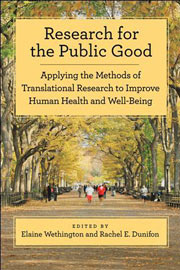The idea of translational research initially sprung out of the field of medicine, where doctors and scientists have teamed up to  move laboratory discoveries more rapidly into clinical settings to help patients improve their health and recover from ailments.
move laboratory discoveries more rapidly into clinical settings to help patients improve their health and recover from ailments.
Since its beginnings several decades ago, researchers working in other disciplines have latched onto the idea of translation. Now a new book offers models for social and behavioral scientists who want to transfer their findings into real world settings.
The book – “Research for the Public Good: Applying the Methods of Translational Research to Improve Human Health and Well-Being” – includes chapters by experts in the fields of psychology, child development, public policy, sociology, gerontology, geriatrics and economics that offer road maps for translating research into policies and programs that improve the well-being of individuals and communities. It is co-edited by Cornell professors Elaine Wethington and Rachel Dunifon.
The book grew out of second Biennial Urie Bronfenbrenner Conference on translational research held at Cornell and attended by leading experts in the social sciences and medical fields.
“Translational research has gained prominence in biomedical research, where there’s an emphasis on speeding lab findings into practice,” Wethington told the Cornell Chronicle. “It also goes back to the work of Urie Bronfenbrenner and his colleagues, however, who were ahead of their time with an ecological approach to human development that brought together research, policy and practice. This book defines the term in that context and provides practical insights for doing translational research.”
Graduate students and early-career scientists unfamiliar with translational research methods should find the book valuable, Wethington said. “There is a surge of interest in the field right now, so the book should be a great resource,” she said.



Speak Your Mind